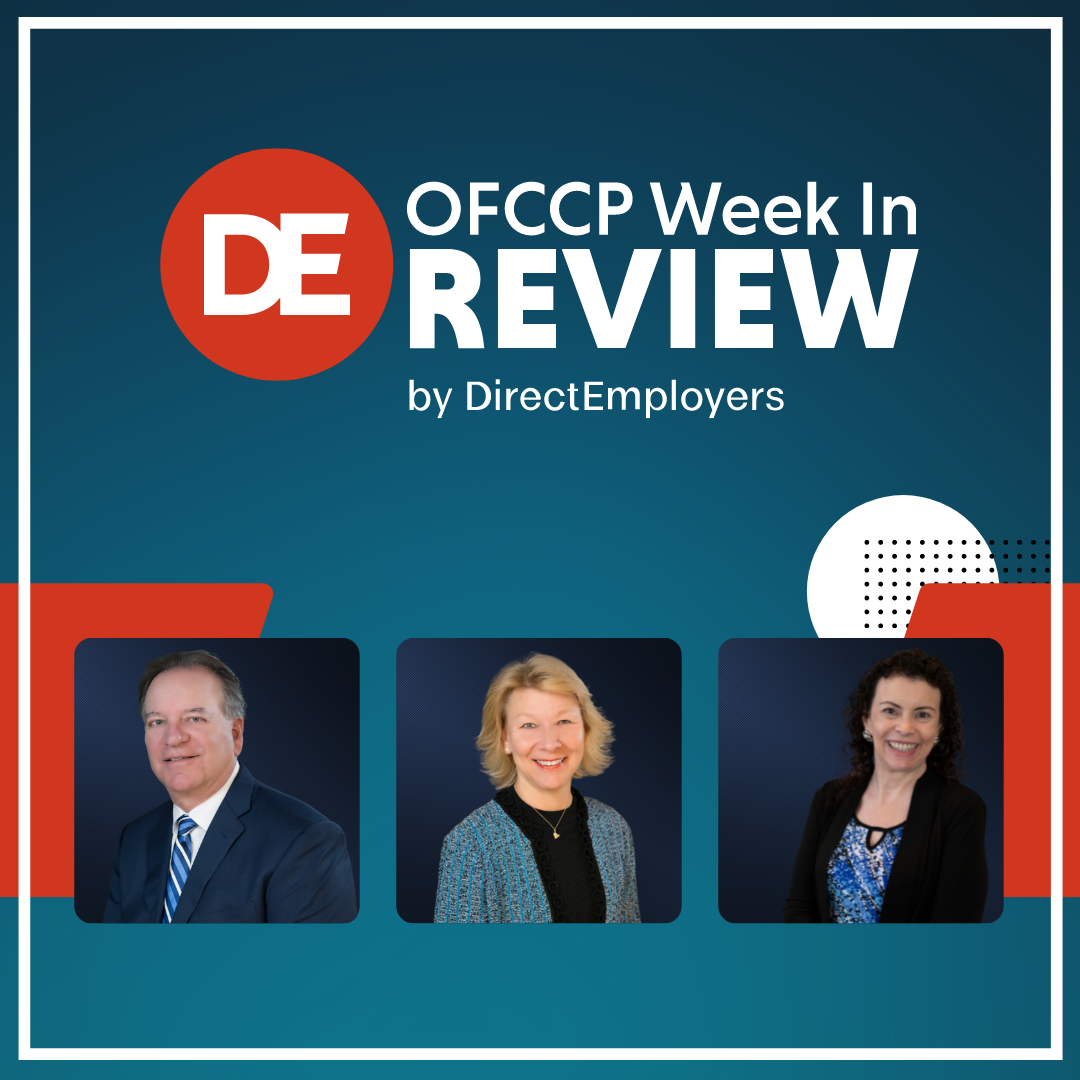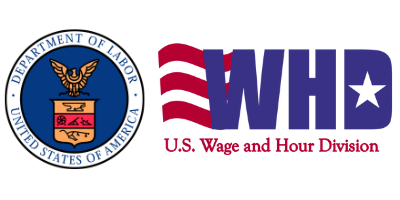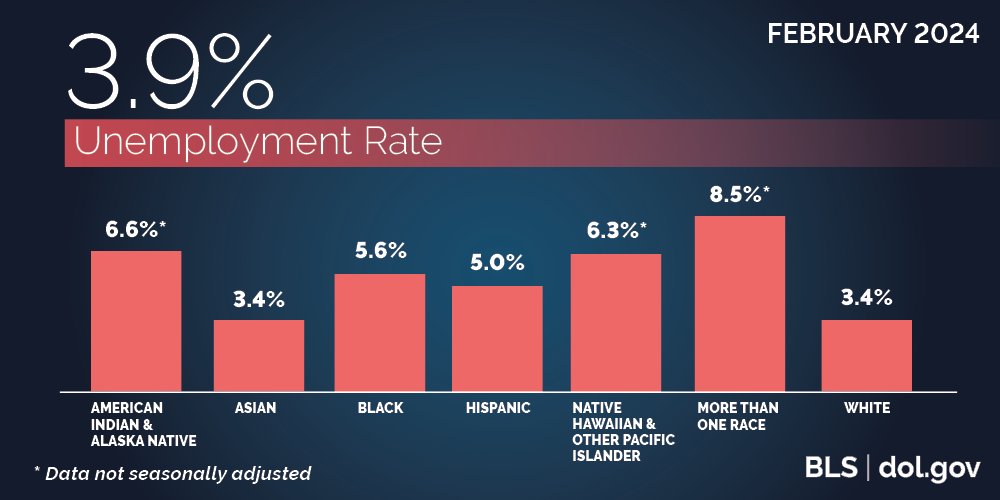 The DE OFCCP Week in Review (WIR) is a simple, fast and direct summary of relevant happenings in the OFCCP regulatory environment, authored by experts John C. Fox, Candee J. Chambers and Cynthia L. Hackerott. In today’s edition, they discuss:
The DE OFCCP Week in Review (WIR) is a simple, fast and direct summary of relevant happenings in the OFCCP regulatory environment, authored by experts John C. Fox, Candee J. Chambers and Cynthia L. Hackerott. In today’s edition, they discuss:
- JOLTS Report – Job Openings Decreased by 26k in January, Rate Unchanged at 5.3%
- U.S. Economy Added 275k Jobs in February, Unemployment Rate Rose to 3.9%
- Recruiters Should Take Four Things Away from the Below “Year-over-Year” Comparison Charts We Have Compiled
- U.S. Trial Court Judge Struck Down NLRB Joint Employer Rule
- President Biden Signed Budget Bill to Partially Fund Government Through End of FY 2024
- In Brief
- New Publications
- Looking Ahead: Upcoming Date Reminders
Wednesday, March 6, 2024: JOLTS Report – Job Openings Decreased by 26k in January, Rate Unchanged at 5.3%

January Job Openings decreased 26,000 from December’s adjusted figure of 8,889,000 to 8,863,000. As of the end of January, the number of “Job Openings” has now decreased for three of the last four months (as noted below in our “Three-Month Comparison Chart”)
Hires also decreased in January (by 100,000 to 5,687,000, compared to the adjusted 5,787,000 number for December)
Total Separations from Work also decreased (by 78,000 from 5,419,000 for December to 5.341,000 in January). Among Total Separations:
- “Quits” decreased by 54,000 (from 3,439,000 to 3,385,000), to a 3 1/2 year low
- “Layoffs” and “Discharges” decreased 35,000 from 1,607,000 in December to 1,572,000 in January
Fewer Job Openings, Quits and Layoffs in January helped to ease labor shortages in some industries.
There were 1.45 jobs available for every unemployed person in the country in January, up from 1.42 in December as the U.S. economy continued to show strength and even as many unemployed workers continued to sit it out.
BLS posted interactive graphs here.
Three-Month Comparison Chart of Job Openings vs. Jobs Filled
Our below table reports the number of available jobs (as taken from the revised JOLTS reports) from the last four months of available data, as revised.
| Reports | October | November | December | January |
| JOLTS available jobs
Prior/mo. comparison |
8,685,000
(665,000 < September) * |
8,931,000
(246,000 > October) |
8,889,000
(42,000 < November) |
8,863,000
(26,000 < December) |
*September Job Openings were 9,350,000
Note: BLS is scheduled to release the JOLTS Report for February 2024 on Tuesday, April 2, 2024.
Friday, March 8, 2024: U.S. Economy Added 275k Jobs in February, Unemployment Rate Rose to 3.9%

- total nonfarm payroll employment increased by 275,000 in February. Job gains were in health care, in government, in food services and drinking places, in social assistance, and in transportation and warehousing
- the unemployment rate increased in February to 3.9 percent from 3.7 percent in January as more workers chose to sit it out
- the number of short-term unemployed workers increased by 334,000 from 6,124,000 in January to 6,458,000 in February
- the number of long-term unemployed (those jobless for 27 weeks or more) decreased by 74,000 from 1,277,000 in January (20.8 percent of the total unemployed) to 1,203,000 (18.7 percent of the total unemployed) in February
- the labor force participation rate was 62.5 percent for the third month in a row. The employment-population ratio was 60.1 percent, a slight decrease from the 60.2 percent rate of the population working in January.
Major Worker Groups
The BLS/DOL charts below illustrate the numbers by race and national origin (data for some groups not seasonally adjusted—which is important at this time of the year for many industries). Black individuals and those who self-identify as Two or More Races are doing better in employment as groups today than before the COVID-19 pandemic as our chart below the BLS column chart shows:
Our table below compares the major worker groups’ numbers from the last three months of available data:
|
The Employment Situation – February 2024 |
||||
| Unemployment Rate |
December 2023 |
January 2024 |
February 2024 | Feb 2020 Pre-Pandemic |
| National (Seasonally adjusted) |
3.7% | 3.7% | 3.9% | 3.5% |
| White | 3.5% | 3.4% | 3.4% | 3.0% |
| Black | 5.2% | 5.3% | 5.6% | 6.0% |
| Asian | 3.1% | 2.9% | 3.4% | 2.5% |
| Hispanic (Seasonally adjusted) |
5.0% | 5.0% | 5.0% | 4.4% |
| Native Hawaiians & Other Pacific Islanders | 4.5% | 5.8% | 6.3% | 2.7% |
| Two or More Races (Not seasonally adjusted) |
4.5% | 5.8% | 8.5% | 6.1% |
| Men (20+) | 3.5% | 3.6% | 3.5% | 3.2% |
| Women (20+) (Seasonally adjusted) |
3.3% | 3.2% | 3.5% | 3.1% |
| Veteran (Not seasonally adjusted) |
3.0% | 3.3% | 2.9% | 3.7% |
| Individuals with Disabilities (Not seasonally adjusted) |
6.7% | 6.6% | 7.7% | 7.8% |
See Also:
- BLS has additional, interactive graphs available here
- President Biden’s remarks
- Acting Secretary of Labor Julie Su’s statement
- USDOL video short illustrating the report
Friday, March 8, 2024: Recruiters Should Take Four Things Away from the Below “Year-over-Year” Comparison Chart We Have Compiled
Your largest pool of available employment recruits are those workers in the “Short-Term Unemployed” bucket.
- The second-largest pool of available employment recruits (but it is far back from the “Short-Term Unemployed” pool) is the “Long-Term Unemployed” bucket.
- Do not overlook converting part-timers to full-time work. That is your third largest pool of available employment recruits. That pool of available employment recruits rivals in size your “Long-Term Unemployed” pool.
- Job Openings are now shrinking noticeably and quickly as the U.S. recovers from the effects of the COVID-19 Pandemic (which the United States declared ended on May 11, 2023, only 10 months ago from today (our publication day = March 11, 2024)). Your competition for recruits is much less intense today than it was a year ago when there were 15% more job openings than today as the effects of the COVID-19 Pandemic are now wearing down.
We were able to catch up over the weekend with Heather Hoffman to get her reaction to the emerging and changing recruitment landscape in the United States.
“Employers must never become complacent in attracting and engaging talent but should continually strive to outrun their competition to find qualified job seekers. With the foundation of recruiting remaining the same, the structure on how to capture the interest of job seekers is continually evolving. Talent Acquisition leaders must constantly evaluate their recruitment marketing strategies regardless of unemployment rates or the labor market. Whether demand is high or low for the talent you are seeking, the war for that talent never stops. You are always competing with other employers for the best candidates.
As an employer, a few questions you should continually ask yourself and monitor are:
- Where are job seekers in my industry spending their time? Is my recruitment marketing strategy represented where they are spending their time?
- Is the culture of our organization where it needs to be or do we need to focus attention on strengthening our culture to not only attract, but also to retain talent?
- Is my employment brand representative of our company’s culture?”
Heather Hoffman is the COO of Recruit Rooster, a wholly owned subsidiary company of DirectEmployers Association devoted to producing recruitment tools for recruiters in all sizes of companies.
The chart below, which is of our own making (our reporter Cyndi Hackerott complied it), shows the January numbers for the specified categories in the years 2020, 2021, 2022, 2023, and 2024. You should know that when the U.S. Bureau of Labor Statistics (“BLS”) first releases a Job Openings and Labor Turnover (“JOLTS”) Report for any given month, the numbers reported are preliminary. BLS also occasionally adjusts the numbers it had initially included in its monthly Jobs Reports. (These are two different reports. You may see both above in today’s WIR). Accordingly, unless otherwise indicated, the chart shows the annually adjusted January numbers for Job Openings, Workers in the U.S. Civilian Workforce, and Short-Term Unemployed. BLS does not have annually adjusted number charts for the Long-Term Unemployed and Part-time Workers Seeking Full-Time Employment categories; therefore, these columns show the January adjusted numbers, as reflected in the report for the following February (at Table A-12 and Table A-8, respectively.) Links for those respective February Jobs Reports are included below the chart.
| Month | Job Openings* | Workers in U.S. Civilian Workforce** | Short-Term Unemployed*** | Long-Term Unemployed (>27 weeks) |
Part-time Workers Seeking Full-Time Employment |
| January 2020 | 7,170,000 | 164,328,000 | 5,842,000 | 1,166,000 | 1,294,000 |
|
January 2021
|
7,185,000 | 160,014,000 | 10,196,000 | 4,023,000 | 986,000 |
|
January 2022
|
11,243,000 | 163,615,000 | 6,549,000 | 1,691,000 | 969,000 |
|
January 2023
|
10,425,000 | 165,871,000 | 5,719,000 | 1,111,000 | 999,000 |
|
January 2024
|
8,863,000 (preliminary) | 167,276,000 | 6,124,000 | 1,277,000 | 1,026,000 |
* For the BLS chart of the annual, adjusted numbers, go here, and select “Job openings level, Total nonfarm, seasonally adjusted – JTS000000000000000JOL”, then type in the yearly parameters.
** For the BLS chart of the annual, adjusted number of workers in the Civilian Workforce, go here, and select “Civilian Labor Force (Seasonally Adjusted) – LNS11000000”, then type in the yearly parameters.
*** For the BLS chart of the annual, adjusted number short-term unemployment numbers, go here, and select “Civilian Unemployment (Seasonally Adjusted) – LNS13000000”, then type in the yearly parameters.
Embedded in the list below are the Jobs Reports for:
Friday, March 8, 2024: U.S. Trial Court Judge Struck Down NLRB Joint Employer Rule
Final Rule Had Been Slated to Take Effect on March 11
NLRB Mulling “Next Steps”

In November 2023, the NLRB extended the original effective date of the Final Rule by two months, from December 26, 2023, to February 26, 2024 (see our story here).
On November 9, 2023, the U.S. Chamber of Commerce and other business groups sued the NLRB in the U.S. District Court in the Eastern District of Texas seeking to permanently block the Final Rule (Chamber of Commerce of the United States of America, et al v. NLRB, No. 6:23–cv–00553). On February 13, 2023, Judge Barker, a Trump appointee, held a hearing on various potentially dispositive motions in the case. On February 22, 2024, Judge Barker issued an order extending the February 26 effective date by another 14 days – to March 11 – to allow him time to consider those pending motions. (See our story here.)
What Did the Judge Say?
In a 31-page Opinion and Order vacating the Final Rule, Judge Barker concluded that the new standard is overly broad because “if an entity exercises or has the power to exercise control (even indirect control) over at least one essential term [of employment], the entity is an employer, jointly with workers’ undisputed employer.” Therefore, “[t]hat would treat virtually every entity that contracts for labor as a joint employer because virtually every contract for third-party labor has terms that impact, at least indirectly, at least one of the specified “essential terms and conditions of employment.”
The NLRB asserted that the “regulatory framework” of the Final Rule involved two steps: (1) an entity must “qualify as a common-law employer of the disputed employees,” and (2) “only if the entity is a common-law employer, then it must also have control over one or more essential terms and conditions of employment.” However, Judge Barker agreed with the Plaintiffs’ argument that “the second test is always met if the first test is met, so the Rule’s joint-employer inquiry has just one step for all practical purposes.”
Judge Barker also issued a separate Final Judgment order. It states in part:
“It is declared that enforcement against plaintiffs or their members of the rule issued by the National Labor Relations Board on October 27, 2023, entitled Standard for Determining Joint Employer Status, 88 Fed. Reg. 73,946, would be contrary to law as to the rule’s addition of a new 29 C.F.R. § 103.40 and arbitrary and capricious as to its removal of the existing 29 C.F.R. § 103.40 (2020). In both respects, the rule is hereby vacated.”
NLRB Chair’s Response
“The District Court’s decision to vacate the Board’s rule is a disappointing setback, but is not the last word on our efforts to return our joint-employer standard to the common law principles that have been endorsed by other courts,” said NLRB Chair Lauren McFerran (D) in a statement issued on Saturday evening. “The Agency is reviewing the decision and actively considering next steps in this case,” she added.
Chamber of Commerce President Applauded Ruling
Judge Barker’s decision “will prevent businesses from facing new liabilities related to workplaces they don’t control, and workers they don’t actually employ,” said U.S. Chamber of Commerce President and CEO Suzanne P. Clark in a press release issued early on Saturday.
Saturday, March 9, 2024: President Biden Signed Budget Bill to Partially Fund Government Through End of FY 2024
Separate Measure Funding US DOL/OFCCP, EEOC, NLRB & Other Agencies Expires March 22

The funding covers:
- Agriculture, Rural Development, FDA, and Related Agencies;
- Commerce, Justice, Science, and Related Agencies;
- Energy and Water Development;
- Interior, Environment, and Related Agencies;
- Military Construction, Veterans Affairs, and Related Agencies; and
- Transportation, Housing and Urban Development, and Related Agencies
“The bills represent the first overall cut to non-defense, non-VA spending in almost a decade,” according to a press release from House Appropriations Committee Chair Kay Granger (R-TX). Senate Appropriations Committee Chair Patty Murray’s (D-WA) statement on the legislation is here. Both press releases contain links to explanatory documents – with their corresponding political spin – on the measure.
More Work to Do
This measure tackled the first half of the federal spending bills needed to ensure government funding through the end of FY 2024. Still pending is the second batch of spending bills to fund the rest of the government – including the Department of Labor/OFCCP, the Equal Employment Opportunity Commission, and the National Labor Relations Board. A Continuing Resolution (“CR”) that funds these agencies at current (i.e., FY 2023) levels will expire on March 22, 2024. See our story from last week for details on that CR as well as the previous measures leading up to it. Legislators anticipate that negotiations on this second batch will be more difficult than the first.
The Funding Fun Continues…
The funding cycle for the FY 2025 will kick off on Monday, March 11, when President Biden is slated to announce his FY 2025 budget proposal.
In Brief
Monday, March 4, 2024: Coming Soon – U.S. EEOC’s Finalized Update to Its Workplace Harassment Guidance

Now that the EEOC has submitted the finalized version, OMB will complete its review process. As per the usual procedure, the finalized version will not be published unless and until the OMB approves it. Generally, OMB has 90 days to complete its review of each submission. However, there is no minimum period for review, and the review period may be extended.
Note that the pending update to this sub-regulatory guidance was NOT listed among the nine items on the EEOC’s Fall 2023 Regulatory Agenda. (See here for our story on the Fall 2023 Regulatory Agenda.) This guidance, in both its current form as well as the upcoming update, does/will not have the binding legal force and effect of law.
Tuesday, March 6, 2024: President Biden Issued EO Instructing Federal Agencies to Incentivize Federal Contractors to Use Registered Apprenticeships

In addition to promoting RAs, EO 14119, in Section 6, re-establishes labor-management forums between federal unions and agency managers.
Friday, March 1, 2024: On the Way – US DOL WHD Submitted Final Overtime Rule for OMB Approval

Once finalized, this Rule will revise WHD’s Fair Labor Standards Act (“FLSA) Rules at 29 CFR §541. Those Rules implement the exemption of bona fide executive, administrative, and professional employees from the FLSA’s minimum wage and overtime requirements. See our stories here and here for details on the proposed version of the Rule. The public comment period on the proposed version closed on November 7, 2023, with almost 26,300 comments submitted.
Now that the WHD has submitted the Final Rule, OMB will complete its review process. Just as with other Final Rules pending OMB review and approval, the Final Rule will not be published unless and until the OMB approves it. Readers may recall from our Fall 2023 Regulatory Agenda story (and our WIR calendar section), that the anticipated publication date for this Final Rule is April 2024. So, the WHD is right on schedule, or even perhaps ahead of schedule.
New Publications
Tuesday, March 5, 2024: U.S. Department of Justice (“DOJ”) officially published its Advance Notice of Proposed Rulemaking (“ANPRM”) on Provisions Regarding Access to Americans’ Bulk Sensitive Personal Data and Government-Related Data by Countries of Concern. This ANPRM is part of the DOJ’s initial plans to implement President Biden’s Executive Order 14117, The deadline for comments is April 19, 2024.
Tuesday, March 5, 2024: US DOL’s Office of Labor-Management Standards posted a “Fact Sheet” on Avoiding Common Errors on the Form LM-20 Report. It provides information to assist labor relations consultants with correctly filing Form LM-20 reports, which detail persuader and surveillance agreements with employers. (See our latest update on Union Persuader Reports for employers (Form LM-10) here).
Friday, March 8, 2024: U.S. Congressional Research Service issued an updated Report on “Labor, Health and Human Services, and Education: FY2024 Appropriations.” The 78-page Report offers an overview of Congressional and Presidential actions, including pending proposals, to provide FY2024 appropriations for the agencies mentioned.
Looking Ahead:
Upcoming Date Reminders
There are three NEW items added to our calendar this week:
November 2023: EEOC’s target date (now overdue) to publish its NPRM to amend its regulations on exemptions to certain recordkeeping and reporting requirements (RIN: 3046-AB28)
December 29, 2023: Statutory deadline (now overdue) for EEOC to finalize regulations to enforce the Pregnant Workers Fairness Act (RIN: 3046-AB30); EEOC submitted its Final Rule for OMB review on December 27, 2023
December 2023: U.S. OSHA’s current target date (now overdue) to publish its Final Rule on Occupational Exposure to COVID-19 in Healthcare Settings (RIN: 1218-AD36); On February 9, 2024, OSHA submitted its Final Rule to OMB for review and approval
March 11, 2024: Previous effective date of NLRB’s Final Rule on Standard for Determining Joint-Employer Status under the NLRA (per U.S. District Judge’s order previous February 26, 2024, effective date extended); NEW On March 8, 2024, a U.S. District Judge vacated this Final Rule – stay tuned for further developments
March 11, 2024: THIS IS TODAY! Effective date for US DOL WHD’s Final Rule on Employee or Independent Contractor Classification Under the Fair Labor Standards Act
March 18, 2024: Comments due on US DOL ETA’s proposal to Modernize its Registered Apprenticeship Regulations
March 19, 2024: Comment deadline for US DOL VETS request to extend – without change – the Information Collection Requirement for its HIRE Vets Medallion Program
March 22, 2024: Expiration date for Continuing Resolution to fund certain government agencies – including the US DOL/OFCCP, the EEOC, and the NLRB – at current levels
March 2024: EEOC’s target date for proposal to amend its regulations regarding the electronic posting of the “Know Your Rights” Poster (RIN: 3046-AB29)
March 2024: U.S. NLRB’s target date for its Final Election Protection Rule (RIN: 3142-AA22)
April 1, 2024: Comments due on FAR Council’s Proposed Rule on “Pay Equity and Transparency in Federal Contracting”
April 3 – April 5, 2024: DEAMcon24 New Orleans – The DEAMcon24 Program is now live!
April 15, 2024: Comments due on EEOC’s Interim Final Rule to Amend Procedural & Administrative Regulations to Include the Pregnant Workers Fairness Act; Corrections Notice here
NEW April 19, 2024: Due date for comments on U.S. Justice Department’s Advance Notice of Proposed Rulemaking (“ANPRM”) on Provisions Regarding Access to Americans’ Bulk Sensitive Personal Data and Government-Related Data by Countries of Concern.
April 23, 2024: Deadline for comments on OFCCP’s proposal to Resurrect, with Changes, Monthly Employment Utilization Report for Construction Contractors
April 26, 2024: Comments due on OFCCP’s Proposed Changes to its Construction Compliance Review Scheduling Letter, Itemized Listing, and Construction Contract Award Notification Requirement Form
April 30, 2024: Deadline to apply for 2024 HIRE Vets Medallion Award – https://www.hirevets.gov/
April 30, 2024: Opening Date for 2023 EEO-1 Survey Component 1 Data Collection
April 2024: U.S. DOL WHD’s current target date for its Final Rule on Defining and Delimiting the Exemptions for Executive, Administrative, Professional, Outside Sales, and Computer Employees (Overtime Rule) (RIN: 1235-AA39); NEW On March 1, the WHD submitted its Final Rule for OMB review
May 13, 2024: Deadline for comments on US DOL’s Request for Information seeking public input on whether to revise the list of Schedule A job classifications that do not require permanent labor certifications to include occupations in Science, Technology, Engineering & Mathematics (“STEM”) & other non-STEM occupations; previous February 20, 2024 deadline extended
May 15, 2024 (11:00 – 5:30 EST): US DOL WHD online seminar on prevailing wage requirements for federally-funded construction projects; register here
May 2024: FAR Council’s target date for its Final Rule to Prohibit TikTok [or any successor application or service developed or provided by ByteDance Limited] on Federal Government Contractor Devices (RIN: 9000-AO58); the Interim Rule is here
June 4, 2024: Deadline for 2023 EEO-1 Survey Component 1 Data Collection
August 29, 2024 (11:00 – 5:30 EST): US DOL WHD online seminar on prevailing wage requirements for federally-funded construction projects; register here
September 2024: OFCCP’s current target date for its Notice of Proposed Rulemaking to “Modernize” Supply & Service Contractor Regulations (RIN: 1250-AA13)
September 2024: OFCCP’s current target date for its Final Rule on “Technical Amendments” to Update Jurisdictional Thresholds & Remove Gender Assumptive Pronouns (RIN: 1250-AA16)
September 2024: EEOC’s anticipated date for amending its FOIA procedures to add fees for electronic disclosure of records (RIN: 3046-AB20).
September 2024: U.S. DOL WHD’s target date to publish an NPRM on “Employment of Workers With Disabilities Under Special Certificates” (Subminimum Wage Rule) (RIN: 1235-AA14)
THIS COLUMN IS MEANT TO ASSIST IN A GENERAL UNDERSTANDING OF THE CURRENT LAW AND PRACTICE RELATING TO OFCCP. IT IS NOT TO BE REGARDED AS LEGAL ADVICE. COMPANIES OR INDIVIDUALS WITH PARTICULAR QUESTIONS SHOULD SEEK ADVICE OF COUNSEL.
SUBSCRIBE.
Subscribe to receive alerts, news and updates on all things related to OFCCP compliance as it applies to federal contractors.
OFCCP Compliance Text Alerts
Get OFCCP compliance alerts on your cell phone. Text the word compliance to 18668693326 and confirm your subscription. Provider message and data rates may apply.



